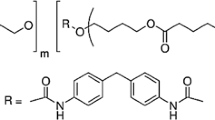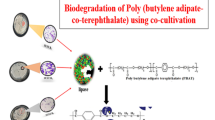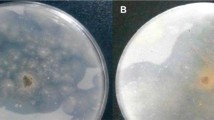Abstract
The present work for the first time investigates the effect of Bacillus amyloliquefaciens, M3, on a new poly(ether-urethane-urea) (PEUU). PEUU was synthesized via reaction of 4,4′-methylenebis(4-phenylisocyanate) (MDI), l-leucine anhydride cyclopeptide (LACP) as a degradable monomer and polyethylene glycol with molecular weight of 1000 (PEG-1000). Biodegradation of the synthesized PEUU as the only source for carbon and nitrogen for M3 was studied. The co-metabolism biodegradation of the polymer by this organism was also investigated by adding mannitol or nutrient broth to the basic media. Biodegradation of the synthesized polymer was followed by SEM, FT-IR, TGA, and XRD techniques. It was shown that incubation of PEUU with M3 resulted in a 30–44 % reduction in polymer’s weight after 1 month. This study indicates that the chemical structure of PEUU significantly changes after exposure to M3 due to hydrolytic and enzymatic degradation of polymer chains. The results of this work supports the idea that this poly(ether-urethane) is used as a sole carbon source by M3 and this bacterium has a good capability for degradation of poly(ether-urethane)s.








Similar content being viewed by others
References
Mathur, G., & Prasad, R. (2012). Degradation of polyurethane by Aspergillus flavus (ITCC 6051) isolated from soil. Applied Biochemistry and Biotechnology, 167, 1595–1602. doi:10.1007/s12010-012-9572-4.
Vroman, I., & Tighzert, L. (2009). Biodegradable polymers. Materials, 2, 307–344. doi:10.3390/ma2020307.
Avérous, L., & Pollet, E. (2012). Environmental silicate nano-biocomposites, green energy and technology. Chapter 2, biodegradable polymers. London:Springer-Verlag. doi:10.1007/978-1-4471-4108-2_2.
Howard, G. T. (2011). Microbial biodegradation of polyurethane. Transworld Research Network, 215, 238.
Loredo-Trevino, A., Gutierrez-Sanchez, G., & Rodrıguez-Herrera, R. (2012). Microbial enzymes involved in polyurethane biodegradation. Journal of Polymer and the Environment, 20, 258–265. doi:10.1007/s10924-011-0390-5.
Oceguera-Cervantes, A., Carrillo-Garcıa, A., Lopez, N., Bolanos-Nunez, S., Cruz-Gomez, M. J., Wacher, C., & Loza-Tavera, H. (2007). Characterization of the polyurethanolytic activity of two Alicycliphilus sp. strains able to degrade polyurethane and N-methylpyrrolidone. Applied and Environmental Microbiology, 73, 6214–6223. doi:10.1128/AEM.01230-07.
Skarja, G. A., & Woodhouse, K. A. (1999). Structure-property relationships of degradable polyurethane elastomers containing an amino acid-based chain extender. Journal of Applied Polymer Science, 75, 1522–1534. doi:10.1002/(SICI)1097-4628(20000321)75:12<1522::AID-APP11>3.0.co;2-A.
Pegoretti, A., Fambri, L., Penati, A., & Kolarik, J. (1998). Hydrolytic resistance of model poly(ether urethane ureas) and poly(ester urethane ureas). Journal of Applied Polymer Science, 70, 577–586. doi:10.1002/(SICI)1097-4628(19981017)70:3<577::AID-APP20>3.0.co;2-X.
Shah, A. A., Hasan, F., Hameed, A., & Ahmed, S. (2008). Degradation of polyurethane by novel bacterial consortium isolated from soil. Annals of Microbiology, 58, 381–386. doi:10.1002/(SICI)1097-4628(19981017)70:3<577::AID-APP20>3.0.co;2-X.
Guelcher, S. A., Gallagher, K. M., Didier, J. E., Klinedinst, D. B., Doctor, J. S., Goldstein, A. S., Wilkes, G. L., Beckman, E. J., & Hollinger, J. O. (2005). Synthesis of biocompatible segmented polyurethanes from aliphatic diisocyanates and diurea diol chain extenders. Acta Biomaterial, 1, 471–484.
Gautam, R., Bassi, A. S., & Yanful, E. K. (2007). Candida rugosa lipase catalyzed polyurethane degradation in aqueous medium. Biotechnology Letters, 29, 1081–1086. doi:10.1007/s10529-007-9354-1.
Wang, G. B., Labow, R. S., & Santerre, J. P. (1997). Biodegradation of a poly(ester)urea-urethane by cholesterol esterase: isolation and identification of principal biodegradation products. Journal of Biomedical Materials Research, 36, 407–417. doi:10.1002/(SICI)1097-4636(19970905)36:3<407::AID-JBM16>3.0.co;2-A.
Gong, C. Y., Fu, S. Z., Gu, Y. C., Liu, C. B., Kan, B., Deng, H. X., Luo, F., & Qian, Z. Y. (2009). Synthesis, characterization, and hydrolytic degradation of biodegradable poly(ether ester)-urethane copolymers based on ε-caprolactone and poly(ethylene glycol). Journal of Applied Polymer Science, 113, 1111–1119. doi:10.1002/app.29946.
Arcana, I. M., Bundjali, B., Hasan, M., Hariyawati, K., Mariani, H., Anggraini, S. D., & Ardana, A. (2010). Study on properties of poly (urethane-ester) synthesized from prepolymers of ε-caprolactone and 2,2-dimethyl-1,3-propanediol monomers and their biodegradability. Journal of Polymer and the Environment, 18, 188–195. doi:10.1007/s10924-010-0189-9.
Asha, S., Mathew, K., Sreenivasan, P. V., Mohanan, T. V., & Kumary, M. M. (2006). Polyurethane degradation in the biological milieu. Trends in Biomaterials and Artificial Organs, 19, 115–121.
Elizabeth, M., Christenson, J., & Anderson, A. (2005). Antioxidant inhibition of poly(carbonate urethane) in vivo biodegradation. Journal of Biomedical Materials, 76, 480–490. doi:10.1002/jbm.a.30506.
Santerre, J. P., & Labow, R. S. (1997). The effect of hard segment size on the hydrolytic stability of polyether-urea-urethanes when exposed to cholesterol esterase. Journal of Biomedical Materials, 36, 223–232. doi:10.1002/(SICI)1097-4636(199708)36:2<223::AID-JBM11>3.0.CO;2-H.
Rafiemanzelat, F., & Abdollahi, E. (2010). Synthesis and characterization of hydrolysable poly(ether-urethane-urea)s derived from L-leucine anhydride cyclopeptide; a green synthetic method for monomer. Polymer Degradation and Stability, 95, 901–911. doi:10.1016/j.polymdegradstab.2010.03.030.
Rafiemanzelat, F., Fathollahi Zonouz, A., & Emtiazi, G. (2013). Synthesis of new poly(ether-urethane-urea)s based on amino acid cyclopeptide and PEG: study of their environmental degradation. Amino Acids, 44, 449–459. doi:10.1007/s00726-012-1353-4.
Rafiemanzelat, F., Fathollahi Zonouz, A., & Emtiazi, G. (2012). Synthesis and characterization of poly(ether-urethane)s derived from 3,6-diisobutyl-2,5-diketopiperazine and PTMG and study of their degradability in environment. Polymer Degradation and Stability, 97, 72–80. doi:10.1016/j.polymdegradstab.2011.10.009.
Correlo, V. M., Pinho, E. D., Pashkuleva, I., Bhattacharya, M., Neves, N. M., & Reis, R. L. (2007). Water absorption and degradation characteristics of chitosan-based, polyesters and hydroxyapatite composites. Macromolecular Bioscience, 7, 354–363. doi:10.1002/mabi.200600233.
Reis, R. L., Julio San Román, J. S., (2005). Biodegradable systems in tissue engineering and regenerative medicine. CRC Press LLC, Ch 12, 0-8493-1936-6/05/$0.00+$1.50.
Acknowledgments
The financial support of this work by Research Affairs Division University of Isfahan (UI) is gratefully acknowledged. We also extend our special thanks to Miss Shahrzad Dehghanfar, M.S. student of Department of Biology, Microbiology Division, and Dr. Delaram Fallahi for the useful help.
Author information
Authors and Affiliations
Corresponding authors
Rights and permissions
About this article
Cite this article
Rafiemanzelat, F., Jafari, M. & Emtiazi, G. Study of Biological Degradation of New Poly(Ether-Urethane-Urea)s Containing Cyclopeptide Moiety and PEG by Bacillus amyloliquefaciens Isolated from Soil. Appl Biochem Biotechnol 177, 842–860 (2015). https://doi.org/10.1007/s12010-015-1782-0
Received:
Accepted:
Published:
Issue Date:
DOI: https://doi.org/10.1007/s12010-015-1782-0




